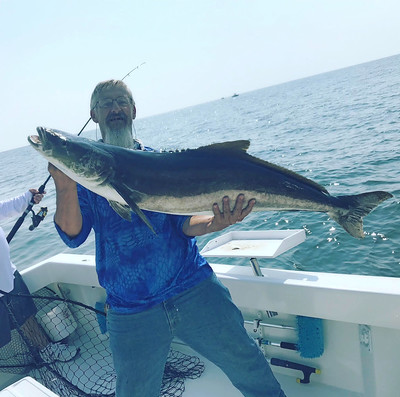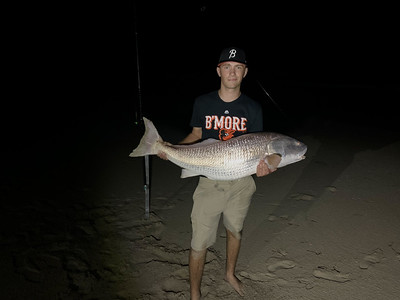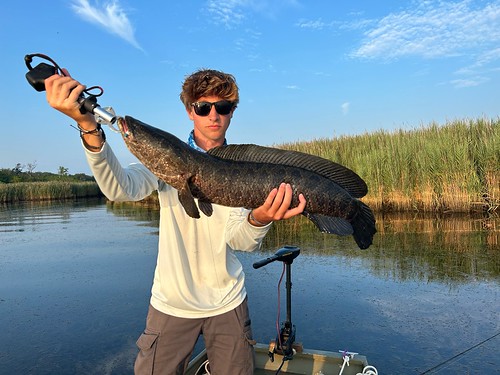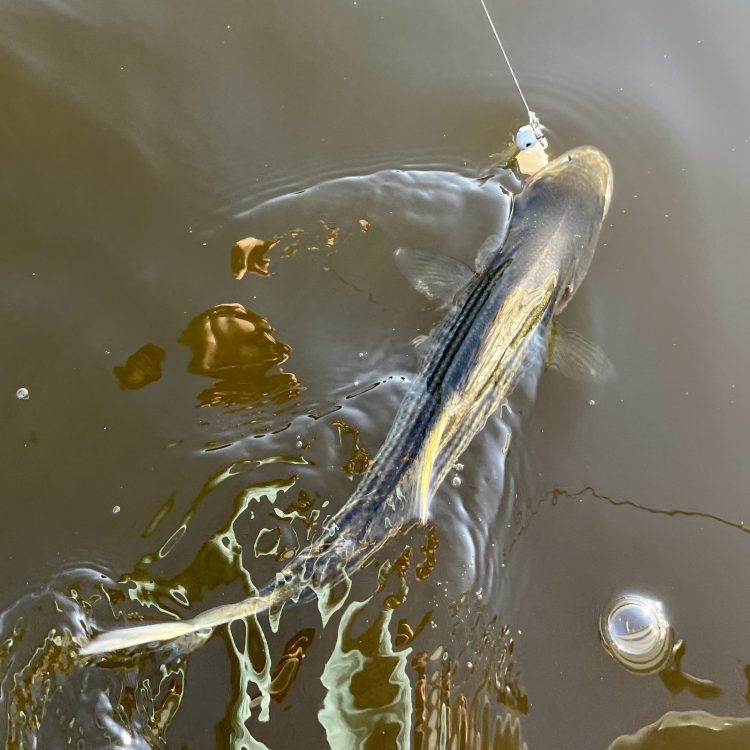Maryland & Chesapeake Bay Fishing Report- August 10, 2023
Spanish mackerel and bluefish blitz in the Bay, cobia take eels drifted through chum slicks, and sea bass, triggerfish and flounder are caught around ocean wrecks.
Tochterman’s Fishing Tackle Report — Baltimore, MD
The Tochterman’s Fishing Tackle Fishing Report is written by Tochterman’s team member, Kevin Trupia.
Striper fishing is still good, with fish being caught at the Patapsco River and north to Pooles Island. Live-lining spot, jigging soft plastics, and topwater plugs are the best ways to target them.
Not much has changed lately with the white perch and catfish bite. They can be found all throughout the bay and its tributaries. Small jigs and small spoons along with live bait like lugworms, bloodworms and grass shrimp are best for the white perch, and cut bait and shrimp are best for the catfish.
Snakeheads are also a fun target for anglers in grassy areas and lily pads with topwater frogs working best. Open water on edges of grass and area piers can produce also with spinners like a #4 Mepps or soft plastics like weedless paddletails or flukes.
You can also check out the White Marlin Open happening this week in OC, MD.
The Tochterman’s Fishing Tackle Fishing Report is written by Tochterman’s team member, Kevin Trupia.
Maryland DNR Fishing Report
Maryland Fishing Report is written and compiled by Keith Lockwood, fisheries biologist with the Maryland Department of Natural Resources.
Fishing is good this week in all parts of the Chesapeake Bay, the Atlantic Ocean and Coastal Bays, and the many freshwater areas throughout the state.
Upper Chesapeake Bay
Anglers in the Conowingo Dam pool and lower Susquehanna River are enjoying fishing for striped bass in the early morning and evening. The dam is on an afternoon-evening power generation schedule so a refreshing surge of cool water flows through the dam pool and the lower river at these times. Popular choices for fishing them include casting topwater lures before sunrise and after sunset, and using jerkbaits, crankbaits, soft plastic jigs, and paddletails.
Striped bass fishing picked up right where it left off at the mouth of the Patapsco River . Anglers are using spot for live-lining with good success during the morning. There is also action at the Key Bridge and north to Pooles Island. Jigging is a good option along the channel edges and near the Key Bridge piers. Farther up the Patapsco near the commercial piers there is good topwater lure action at dawn. There has also been good striped bass fishing by live-lining and jigging at the Love Point rocks.
White perch can be found in all upper Bay tidal rivers and can be caught fishing with grass shrimp, pieces of bloodworm, peeler crab, or small minnows when fishing in deeper waters. During the early morning and late evening, casting roadrunner lures, small spinnerbaits, or jigs is a fun way to catch white perch.
Blue catfish provide plenty of fishing opportunities and can be found in the tidal rivers and the uppermost parts of the Bay. Fishing the bottom with fresh cut bait of menhaden is the most popular way to find them, and other bait options can work well also.
Middle Bay
Striped bass are being caught on the east side of the Bay Bridge at the 30-foot drop-off. The fish are holding tight to the bridge piers during a good running tide. Drifting with live spot, small white perch, or soft crab baits works well.
The rocks along Poplar Island and Thomas Point are also good places to cast topwater lures or paddletails fro striped bass. Speckled trout, bluefish, and puppy drum are also a welcome addition to the mix being caught.
Bluefish can be found throughout the middle Bay this week; along the edges of the shipping channel and the False Channel area, Spanish mackerel can be mixed in with them. The shipping channel edge from Buoy 83 south past the Sharps Island Light is a very good place to target Spanish mackerel this week. When trolling, a mix of bright-color Drone Spoons or gold Clark spoons behind No. 1 planers at 7 to 8 knots is the best way to target them. Keep an eye out for diving gulls and you may find some topwater action from Spanish Mackerel and bluefish as they feed on bay anchovies.
White perch continue to offer plenty of summer fun fishing off docks and piers and on the shorelines of the Bay and tidal rivers. Grass shrimp, pieces of bloodworm, peeler crab, or small minnows are great baits to use on a simple bottom rig when fishing deeper waters close to structure. Small spinnerbaits and soft plastics will also catch them early or late in the day, and fly anglers can target them with a 5-weight and bright-colored Clouser minnows.
Lower Bay
Striped bass are hitting topwater lures, jerkbaits, and paddletails near the river mouths early in the morning and late in the evening. Speckled trout, bluefish, and puppy drum are also part of the mix, especially on the Eastern Shore. The main stem of the Potomac River remains closed to striped bass fishing until August 20, but anglers can fish the Maryland tributaries, such as the St. Marys River. Virginia waters do not open to striped bass fishing until October 4.
Bluefish are being caught by trolling or casting metals and topwaters into breaking fish, which is also proving a successful tactic for Spanish mackerel. Approach carefully from the upwind side of the action and quietly drift into casting range. A fast retrieve will attract mackerel while the slower retrieves will get the attention of bluefish. Trolling Drone spoons or Clark spoons at speeds of 7 to 8 knots around the shipping channels should also yield some Spanish mackerel.
Large red drum continue to frequent the area around the Target Ship, the Mud Leads and the Middle Grounds. At times they can be found under breaking Spanish mackerel and bluefish, and other times slicks and churned-up water can indicate their presence. Jigging with large soft plastics or dropping soft crab baits will entice them for some exciting catch-and-release action.
Cobia can be found near Smith Point and near the Target Ship; there are not many to be found but it only takes one legal-sized cobia to make your day. Most anglers are chumming and fishing with live eels in the back of their chum slicks.

Atlantic Ocean and Coastal Bays
Surf anglers are catching a mix of kingfish and spot on bloodworms and artificial bloodworm baits. The best fishing is occurring during the early morning. Bluefish can be caught on finger mullet. At night large red drum continue to be caught and released, as are a mix of inshore sharks.

At the Ocean City Inlet, sheepshead are being caught on sand fleas near the jetties and the Route 50 Bridge piers. Bluefish and striped bass are being caught on soft plastic jigs and by drifting cut bait. In the back bay channels flounder fishing has been good during the top of the flood tide and the beginning of ebb.
Fishing for sea bass, triggerfish, and flounder continues to be good at the wreck and reef sites. At the canyons, a mix of bigeye and yellowfin tuna are being caught. Small dolphin are being caught near the lobster buoys and any floating debris. Blueline and golden tilefish are being caught at the canyon edges.
Freshwater Opportunities
To better facilitate fishing for invasive blue and flathead catfish, the Department of Natural Resources has instituted a regulation change regarding cut bait in non-tidal waters. Anglers will now be able to use cut bait of fish, such as bluegill sunfish, with no minimum size restrictions. There is a maximum of two pounds of cut bait allowed in an angler’s possession.
Largemouth bass are the choice target for most anglers in local ponds, reservoirs and in the rivers, but a mix of chain pickerel, bluegills, and crappie can also be found.

Northern snakeheads are in various stages of spawning and protecting fry balls of their young. They can be found in the shallows in thick grass. Casting buzzbaits, chatterbaits, and soft plastic frogs can often annoy them enough to strike. They are not feeding but will protect their young from perceived threats, so it may take more than one cast to get them to strike.
Maryland Fishing Report is written and compiled by Keith Lockwood, fisheries biologist with the Maryland Department of Natural Resources.
Angler’s Sport Center Fishing Report – Annapolis, MD
The Angler’s Sport Center fishing report is compiled and written by Anglers Team Member, A.J. Lewis.
Upper and Middle Bay
The Chesapeake Bay Bridge is providing excellent fishing opportunities for anglers targeting spot, small croaker, white perch and even the occasional small sea bass or toadfish! Fishing tight to pilings on the western side of the bridge using bottom rigs tipped with bloodworms or lugworms will net a good amount of these smaller fish.
The mouth of the Patapsco River is offering amazing opportunities to net keeper sized striped bass while live-lining spot. Locations like the Key Bridge and around the Chesapeake Bay Bridge pilings are fantastic for jigging for good sized striped bass as well.
The Conowingo Dam is generating cooler water daily at the dam pool. Anglers are finding success using all kinds of lures and baits, but the best fishing is reserved to early morning hours before sunrise, or, late in the day after sunset.
White perch can be found in all tidal rivers of the upper and middle Bay area! Casting small spinners, such as a Perch Hounder, near structure is a fun way to catch a good amount of white perch.
Bluefish and Spanish mackerel are being caught around the edges of the shipping channel and False Channel area. Trolling where mackerel or bluefish are seen breaking on the surface is the best way to get on a good amount of these fish. You can also cast topwater lures and light metal or epoxy jigs into the surface activity and a steady- to fast-retrieve will attract blues and mackerel.
Captain LJ, Owner of G-Eye Jigs, stated “I’ve been catching keeper croaker, nice white perch, spot and black sea bass around the Chesapeake Beach area. Mackerel and Bluefish are around but elusive. Trolling seems to be the most successful!”.
South Bay
Middle Ground and the Target Ship are host to good sized cobia and red drum! Jigging with large soft plastics or drifting soft crab and cut bunker seem to be the most effective tactics.
Trolling along the shipping channel is proving to be an extremely effective way to to catch Spanish mackerel. 00 spoons underneath a number 1 planer while trolling at 6 to 8 m.p.h. will get you plenty.
Until August 20th, fishing for striped bass is closed in the main stem of the Potomac River. However, the mouth of the Potomac offers a great mix of blue catfish and speckled trout. Further up the Potomac you’ll find a good mix of channel cats and blue cats in large numbers.
Captain Travis of Schooled Up Fishing Charters says “Lots of large Blues south and scattered Mack’s. Drums also in the mix south.”
Additional Info.
Striped bass are once again open for fishing in most parts of the Chesapeake Bay! They’ve returned to the 19- to 31-inch slot, with a limit of 1 per day, per angler.
Recreational crabbing in the Magothy is very productive in areas of 4- to 7-inch depth. Crabbers are reporting razor clams to be the most favored bait at the moment.
The Angler’s Sport Center fishing report is compiled and written by Anglers Team Member, A.J. Lewis.
Reel Chesapeake Fishing Report – Annapolis, MD
The Reel Chesapeake Fishing Report is written and compiled by writer and media professional, James Houck. Find the full report here, at reelchesapeake.com.
The middle Chesapeake Bay region is setting up for, what could be, a fine week of fishing heading into the midway point of August. Big storms blew through the entire Mid-Atlantic stirring up the watersheds, oxygenating them top to bottom, and activating a slight cool down, which has energized multiple fisheries. All of this syncs with a waning moon toward new and the strongest tides occurring at dawn/daybreak by this weekend and into early next week. If you’ve been itching to hit topwater for striped bass at sunrise, as I have, this is our week coming up. We should also see blues and macks feeding voraciously on abundant baitfish, so the trolling game also could be hot.
Anglers have been reporting good catches from the northern end of the bay to southern for a variety of species. Most reports have been stripers, bluefish, specks, macks, and bull reds. Striped bass continue to hold and feed in the Patapsco River around Fort Carroll. The Six-, Seven-, and Nine-Foot Knolls should also have schools foraging near the mouth and further into the main stem. In most of the middle bay rivers, the mouths are active and offer a shot at a trifecta of stripers, blues, and macks. Most of them won’t exceed 20 inches, but larger fish can be in the mix. Keep a rod rigged with a 1/2-ounce silver Kastmaster or even a G-Eye rain minnow—you can either jig it deeper for stripers or burn your retrieve up top for the chompers. The Eastern side of the channel seems more active recently.
Light tackle casting or trolling has been very good for anglers plying shorelines and shallower water further into the rivers. Large pods of baitfish continue to fill the creeks and at dawn and dusk, the water looks like it’s sizzling with activity with occasional blitzes of 17-inch-class stripers. Topwater poppers, ploppers, and walking baits can trigger exciting strikes. Jigheads from a 1/4 ounce up to 1/2 ounce tipped with 3- to 7-inch paddletails are also excellent for subsurface hits. If you’re fishing over grass flats, try a brightly colored paddletail or fluke rigged weedless for a shot at speckled trout, or even a puppy drum. There have been several such catches in the lower Choptank area, and a couple randoms in the Severn River.

Much further south, the bull red action has been fantastic with multiple charters putting their clients on 40- to 50-inch class fish. Captain Travis Long of Schooled Up Charters (@schooled_up_charters on Insta), for example, has demonstrated an excellent August thus far in this regard. Expect to depart Chesapeake Beach, Solomons, and Point Lookout for a shot at these bigs, which are from Taylors Island down to Smith. Continue pushing into Virginia and there may be crossover water with cobia. The biggest bluefish (a few 30 inchers!) in the bay are also down this way.
In the middle and upper sections of major tributaries like the Potomac, Patuxent, Choptank, and Nanticoke, anglers continue to encounter classic summer patterns for largemouth bass and northern snakehead. In the past week, we’ve personally caught both species in the Patuxent. Topwater frogs attract the bigger fish and, occasionally, overzealous juveniles. Sight fishing has been solid for snakehead overall, and folks fishing the entire Blackwater system on the Eastern Shore are enjoying what’s become, perhaps, the best northern snakehead fishery in the U.S.
Smallmouth are also active in the western sections of the Potomac, Pax, and Susquehanna above Conowingo. Small jig/grub combos worked in holes and seams can get fish to strike. Earlier this week, we waded a shallow, rocky section of the Middle Patuxent near Savage, Maryland, catching tiny smallmouth. A very refreshing and cool way to fish during the hottest days of the year. Good luck!
View the full Reel Chesapeake Fishing Report, written and compiled by writer and media professional James Houck, at reelchesapeake.com.
Leave a Reply